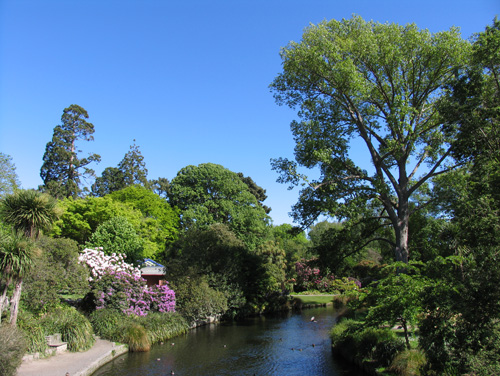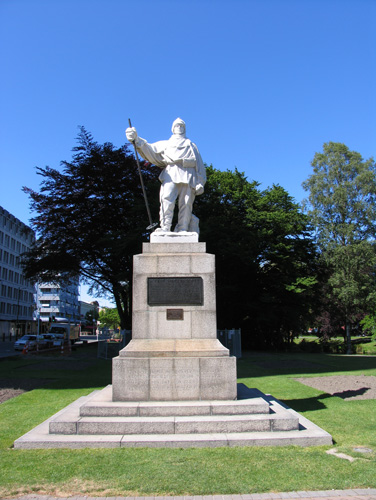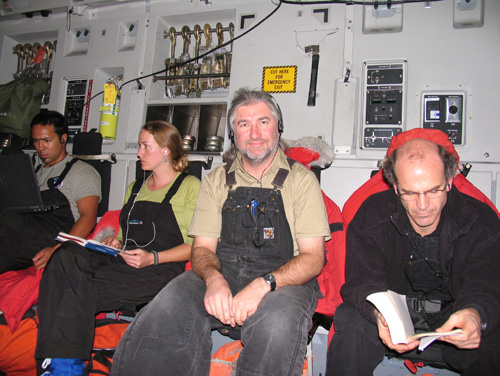Week 1 November 4 - 11 2007 Traveling to the Ice
Most years since 1995 my attention has been focused on Antarctica for the period roughly October till February. During this time I've usually done a trip to Antarctica lasting from a month at the minimum to over a year. Even outside this period my work life revolves around supporting activities at the South Pole. Emails to and from the South Pole, even picking up the phone and calling the Pole are every day activities for me. It is easy to forget how remote and exotic Antarctica is to people that have never had this close connection to the polar regions. If the subject of my work comes up in a social situation it often results in a flurry of questions. One of the most common questions is "how do you get to the South Pole?". Since it is fresh in my mind, I should describe it.
Going to the South Pole really starts about 8 months before doing any travel. This is when support personnel are hired and science projects start picking the people they will send to work on their experiments. In the case of IceCube I lead a small team to maintain the computing infrastructure of the experiment. The team is usually less than 10 people in total (only 5 this year) with maybe 3 at most at the Pole at one time, compared to the IceCube project overall which has over 50 people on station at one time all summer season. Based on the work that will be done we decide who should go down, when, and for how long. Then these names are submitted to the NSF, along with all the other IceCube team members.
Once your name is submitted you are sent a "deployment package" with the numerous forms to fill out, from information about your clothing sizes, travel preferences, and most importantly a medical kit. For summer people a medical kit will include a medical questionnaire and instruction on getting blood tests done, having a medical examination, and a dental examination (with many dental X-rays). For people wanting to winter there is also a psychological exam to pass.
It's important to get the medical process over with quickly in case issues need addressing, maybe you need a crown or follow up blood tests. If all goes well with the medical, all a scientist has to worry about is planning their work on the ice until about a month before deploying. This can be a bit involved. Soon enough you are contacted to let you know you a PQed (Physically Qualified) to go south, or maybe you NPQ. Assuming you PQ you are sent airline tickets, hotel details in Christchurch, and some distinctive luggage tags that clearly identify you are being part of the United States Antarctic Program.
The short answer which I usually give for how do you get to the South Pole is that you travel commercial airlines to Christchurch New Zealand, and from there take a couple of US military flight to the South Pole, first a C-17, and then a Hercules. The commercial part of the flying is usually straight forward. Sometime slightly complicated by having excess luggage carrying science equipment with you. Because people with USAP are sent to Christchurch in waves, by the time you reach Los Angeles International you will start noticing people with hand carry bags with distinctive USAP luggage tags on them.
Once in Christchurch there is only 2 things most people have to do, remember to go to their clothing issue, and turn up in time for their flight to McMurdo. This leaves at least a full day to explore Christchurch and relax. I changed my usual hotel this year, and stayed in the more expensive Heritage. I had to track down some cargo, and send some work emails as soon as I arrived, but was soon enough in my comfortable hotel room.
The next morning the effects of jet lag had me up by 5am. This gave me plenty of time to go for a walk through the wonderful botanic gardens, catch up with a friend, and finally catch a bus to the CDC (Clothing Distribution Center) for my ECW (Extreme Cold Weather) issue.

The Botonical Gardens in Christchurch
I'll leave describing the ECW gear until a future email, but I will mention that I mostly have my own personal gear and only use the outer shell, boots, and a few other items from the CDC. The staff their have stream lined this process, knowing what you took previous trips, and clothing issue was quickly over for me.

Bags ready for departure at the CDC
The CDC is part of a larger complex called the Antarctic Center which includes offices for USAP, the New Zealand and Italian Antarctic programs, an APO (Air Post Office), travel center, and a visitors center. The visitors center is worth a look if you are ever in Christchurch. They have a cold room where you can experience some cool modest wind, with blizzard sound effects. There are static displays of science and life in Antarctica, and a small aquarium with Little Blue penguins. Also popular are rides in a common over snow vehicle called a Haggland.

Antarctic Center with Visitors Center on the left and offices on the right
After the clothing issue you are given a reporting time for your flight south. When we arrived it was clear there was still people in Christchurch heading south. This was due to flights being cancelled because of bad weather in McMurdo for 4 days previously. This is not uncommon. But at some point the number of people on the flight does get large. I was told by one of the staff that they expected a small window for flying and I think that is why we had a very early 2am reporting time.
I had a relaxing afternoon doing some book shopping and had an early dinner at my favorite local restaurant, the Dux Delux, which happens to be a brew pub. As this is a popular place for ice people, I met up with friends. The jet lag soon had me and I was back at my hotel early.

Statue of Captain Scott in Christchurch
Even with plenty of sleep my alarm at 1am seemed awfully early. Every trip south I tend to make some small mistakes here and there. There are some cardinal rules which I have never broken, such as being late. Maybe it was the early hour but I quickly packed, got into my clothes, which are the same ones I will wear under my ECW (so not quite street wear), and headed out to check out and catch my shuttle. That's when I noticed the note under my door, the thing I should have checked for first thing. Delayed 24 hours.
I went for another walk in the botanic gardens in the morning, and had a leisurely breakfast at the cafe next to the impressive Cathedral in the square. By the time I got back to my hotel there was a message saying I needed to phone the travel department asap. I had a quick panic as I'd been slightly confused when I saw a shuttle of ice people on the road on my way back. Maybe we were flying? No, the Heritage was full and I had to move hotels, unless I didn't mind moving into a suite with PJ. Did I know PJ? I sure did, and having stayed in the luxury suites in the past I said YES! The suites at the Heritage are in a building next door to the main hotel, in an old sand stone building, imaginatively named for it's previous function, "The Old Government Building", or OGB for short. The suites have 2 large bed rooms, a kitchen and dinning area, and in general are full of character. The toilets near the bar which are in what used to be old vaults, have their original huge steel doors on them - amazing.
Getting stuck for awhile in Christchurch is not uncommon. I think my record is 12 days a number of years back. To make a long story short we ended up staying yet another day. While sometimes being suck can be stressful, especially if you need to get to the ice by a very specific date, this was not the case this year. I was enjoying being in CHC, in a luxury hotel, Australia playing Sri Lanka at the Gabba on TV, with the mornings to wander around in beautiful weather. It couldn't last.
On Saturday morning we made it out to the CDC and the staff were anxious to see us gone. I've written a very detail account with gory details of getting to the South Pole aimed at helping other people doing the same for the first time, which is on my web site. So briefly we arrive at the CDC and get dressed in ECW. We drag all our luggage to the departure terminal next to the CDC where we are weighted, clear NZ departure customs, have our checked bags taken off us, and given a boarding pass and a departure time. We then dump our gear in the departure lounge and get to go have breakfast at the visitors center. When we return we are shut in for departure briefings and finally have to clear security. Yep, they put us through the same security as a commercial flights, no sharps or liquids in our hand carry. While this might strike you as strange it will get more absurd later.

Security at the Antarctic Departure Terminal. Notice bags being carefully loaded in the background.
After setting the walk through metals detector crazy with numerous metal zips and snaps, we get a boxed lunch (gone are the brown paper bag lunches), and into a bus for a ride across the road to our waiting aircraft at the Christchurch airport. Most passenger flight between Christchurch and McMurdo these days are US Air Force C-17 cargo jets. The seats are comfortable, the aircraft roomy, and in general infinitely better than the old days of C-141 jets, or the more occasional C-130 flight. It is still possible to do this leg by C-130, but it is rare now.
We're quickly loaded and given the usually indecipherable safety demonstration on a hidden life vest, and complex dangerous looking plastic bag with oxygen bottle. I was seated along the side of the aircraft, as opposed to the pallet mounted actual seats in the center. Directly above me was a fire axe with instruction on the best spot to hack into the fuselage. The flight to McMurdo in a C-17 is painless. There is a real aircraft toilet, plenty of space, and comfortable seats. It is only about 5 hours, and for the last part there is often great views of sea ice and mountains, but not many windows.

Inside a C-17 Cargo jet.

Me comfortably on my way to McMurdo.
Arriving in McMurdo we are quickly moved from the aircraft to waiting shuttles, and the famous Terra Bus. The views of Mt Erebus and the mountains from the runway can be spectacular. It's a shame they feel they have to rush us so much at this point. Especially for first timers this should be something they get a chance to savor.
Usually we would be taken to a place called the Chalet, the NSF building in town. But our group was too large and we were sent to the galley. Here we went through the usual arrival briefings. In the past I've described this as the most painful part of the trip south. And even though the galley version is better than the stuffy Chalet version, I still stand by this statement. See my other guide for more gory details.
The down side to flying to MCM on Saturday is that Sunday is a no fly day. This gave us a full day to waste there. There is a lot to do in town, such as walk down to Scott's Discovery Hut, walk up Observation Hill for the views and to see the memorial cross for Scott and team, and smaller things such as go to the store at Scott Base or use an ATM in Antarctica (Wells Fargo). I've done these many times, and still had lots of work to do which I could do by email, so spent most of Sunday in the Crary science lab. There is a nice library with work desks, and big picture windows looking out across McMurdo Sound to the mountains in the distance. There are worse ways to spend a day.
The evening before a flight to Pole you have to bag drag, which is report to the MCC (McMurdo Control Center) with all your gear for weight in, and checking of bags. Sort of like a transfer desk but at the top of a hill. Our reporting time was 7:30am the next day; very civilized.
Unlike flying to McMurdo, which is like flying to a destination that isn't any colder than Minneapolis in winter, you have to dress seriously for the flight to South Pole. You put this all on at 7:30 at the MCC. This means you end having a very hot ride out to your waiting aircraft. The Hercules that fly to the South Pole are ski equipped and thus have the extra letter in their designation, LC-130. They are flown by the Air Nation Guard (ANG) based out of New York state. These aircraft are loud and the webbing bench seats not very comfortable. But at only a couple dozen PAX (passengers), and only 3 and a bit hours to Pole, the flight isn't too bad.
No mater how many times I go to Pole I'm always surprised how cold it is. By the time you get to Pole the confinement of the Herc, the noise, and general din (as the aircraft never shuts down at Pole) it is definitely disorienting. Thus the load master gives clear instruction on which direction to turn on exiting the aircraft to help you avoid walking into the propellers. There is about a 50 yard walk off the taxi way to get to the waiting crowd. I don't have a clear memory of my first time to Pole. I'm sure I was excited. These days I'm not sure how I feel about it. It's nice to bet by friends, and it was great of Dave to take me the short distance to the station by snow mobile. Forcing myself to come up with some feelings about this, maybe relief I'm off the aircraft, surprised I'm back again, and maybe tired. As soon as Beth gave me my housing assignment I went and lay down for a nap.
To be continued.

